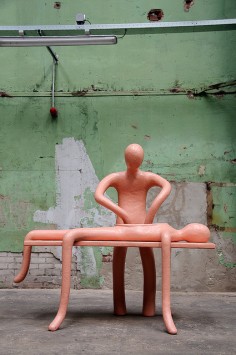Atelier Van Lieshout
Infernopolis
source: ateliervanlieshout
AVL´s workshop is situated in a large old warehouse in the harbours of Rotterdam. The building, Katoenveem, is an industrial monument, since it is one of the first warehouses of concrete. It was build by architect J. J. Kanters in 1920. The warehouse was originally used to store cotton in.
Artworks and a host of other products begin their lives here before travelling to points around the globe. The workshop has different departments, a fibreglass, sculpture, wood, and metal workshops. AVL’s 20 employees have different backgrounds and origins. The designers are closely involved in the manufacturing process of each product. Design and making of the art works all take place in this workshop.
.
.
.
.
.
.
.
.
source: thisistomorrowinfo
Two enormous installations, ‘The Technocrat’ and ‘Cradle to Cradle’, are installed amid a forest of existing and new sculptures. A unique partnership between the Port of Rotterdam and Museum Boijmans Van Beuningen.
At ‘Infernopolis’ you can move among sinister installations and tableaux in which the distinctions between good and evil, life and death, and reality and fiction are erased. Atelier Van Lieshout’s fascination with systems is clearly manifest in the art work The Technocrat (2003-2004), which comprises all manner of apparatus, containers, beds and distillation vats. Together they form a closed circuit of food, alcohol, excrement and energy. Cradle to Cradle (2009) takes the principle that human waste can be food to the extreme. Looking at this art work, it quickly becomes clear that this machine recycles everything, even people.
The exhibition in the Submarine Wharf contains Atelier Van Lieshout’s most recent sculptures, which have never previously been exhibited. These works illustrate the evolution of a new culture resulting from a society of over-consumption and scarce resources. In this culture we see a harshening of relations between people and an increased will to survive. Through battle scenes and a large, abstracted cannon (WW III, 2010) Atelier Van Lieshout provides a glimpse of a possible future. The sculpture Cascade by Atelier Van Lieshout, recently placed at Churchillplein in Rotterdam illustrates this theme as well.
Joep van Lieshout (1963, Ravenstein) lives and works in Rotterdam. Since the eighties he produces objects in polyester, the material that would become his trademark in subsequent years. In 1995 he founded Atelier Van Lieshout, undermining the myth of the individual artistic genius. Atelier Van Lieshout has attained international recognition for objects that occupy the middle ground between art, architecture and design.
The exhibition in the Submarine Wharf is a partnership between the Port of Rotterdam and Museum Boijmans Van Beuningen. The Port of Rotterdam initiated the partnership and asked Museum Boijmans Van Beuningen to organise the exhibition by Atelier Van Lieshout. The Submarine Wharf, built between 1929 and 1938, is comparable in size to the Turbine Hall at Tate Modern in London.
.
.
.
.
.
.
.
source: petry-artblogspot
Dans le travail de Joep Van Lieshout et de son équipe, une thématique est récurrente : la place de l’Homme dans le monde qui l’entoure, qu’il matérialise sous forme de sculptures.
Avec l’aide de résine spécial, l’atelier explore le corps humain, sous tous ses aspects, aussi bien ce qui se trouve à l’intérieur qu’à l’extérieur.
Et c’est ainsi qu’en 2009, on voit apparaître une série d’œuvres mettant en scène le corps humain en interaction avec du mobilier ( Hollow Sitting Man on Table, La Chaisse ou encore Old man). On voit évidemment que ce lien est exagéré et même poussé à l’extrême, le corps humain semble se comporter tel une matière visqueuse, dégoulinante et étonnement vide.
La sensation qui se dégage de ce travail est la souffrance ; comme si ces objets étaient des engins de tortures. De là, se dégage un questionnement sur les « outils » qui ont été créés par l’homme.


